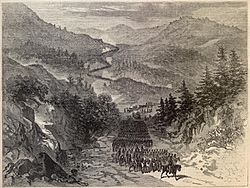Battle of the Cumberland Gap (1863) facts for kids
Quick facts for kids Battle of the Cumberland Gap |
|||||||
|---|---|---|---|---|---|---|---|
| Part of the American Civil War | |||||||
 |
|||||||
|
|||||||
| Belligerents | |||||||
| Commanders and leaders | |||||||
| Ambrose E. Burnside | John W. Frazer |
||||||
| Strength | |||||||
| 3 brigades | 2,400 | ||||||
| Casualties and losses | |||||||
| 0 | 2,300 surrendered | ||||||
The fall of the Cumberland Gap was an important event during the American Civil War. It happened between September 7 and 9, 1863. This battle was a big win for the Union Army, led by General Ambrose Burnside. It was part of his plan to take control of Knoxville, Tennessee.
What made this battle special was that almost no one was hurt. It's called a "bloodless" victory. Even without a big fight, the Union captured about 2,300 Confederate soldiers. They also took control of the Cumberland Gap, which was a very important location.
Contents
Why the Gap Was Important
The Cumberland Gap is a natural pass through the Appalachian Mountains. It's where the states of Tennessee, Kentucky, and Virginia meet. Because of its location, it was a key route for moving soldiers and supplies. Both the Union and Confederate armies wanted to control it.
Burnside's Plan for Knoxville
In August 1863, Major General Ambrose Burnside was in charge of the Union's Army of the Ohio. He started moving his troops from Cincinnati, Ohio. His main goal was to capture Knoxville, Tennessee. This city was important because of its railroads and resources.
The most direct way to Knoxville was through the Cumberland Gap. However, Confederate soldiers were holding the Gap. Burnside didn't want to waste time fighting there. So, he decided to try a different plan.
He sent one group of soldiers, called a brigade, to pretend to attack the Gap. This brigade was led by Colonel John F. DeCourcy. Their job was to keep the Confederate general, John W. Frazer, and his 2,300 men busy. Meanwhile, the rest of Burnside's army took a longer, harder route. They marched over 40 miles through rough mountains to the south.
Confederate Challenges
Burnside's plan worked well. He quickly reached and took Knoxville on September 2. Many Confederate soldiers in eastern Tennessee had already left. They were sent to fight in another big battle called Chickamauga. This left fewer soldiers to defend places like the Cumberland Gap.
General Frazer and his men were left to defend the Gap. They didn't have much fighting experience. But they had a strong natural position and had dug trenches to help protect themselves. Frazer had strict orders to hold the Gap no matter what. However, the general who gave him those orders, Simon Bolivar Buckner, and his troops had moved away. This left Frazer without a clear plan if things got bad.
The Battle for the Gap
Even with Colonel DeCourcy's brigade threatening them, Frazer's men were not ready to give up. So, General Burnside sent another Union brigade. This one was led by Brigadier General James M. Shackelford. Shackelford's troops came from the south. On September 7, he asked Frazer to surrender, but Frazer refused.
There was some shooting with cannons, but it didn't do much. That evening, Union soldiers managed to capture Gap Springs. This was the main water supply for the Confederates. Losing their water was a big problem for Frazer's men.
Burnside Arrives
On September 8, General Burnside himself left Knoxville. He brought another brigade of soldiers, led by Colonel Samuel A. Gilbert. Burnside and his men marched an amazing 60 miles in just over a day. This showed how determined he was to take the Gap.
Meanwhile, both Colonel DeCourcy and General Shackelford kept sending messages to Frazer. They demanded that he surrender. Frazer tried to buy time by meeting with the Union commanders separately. But he still said no to surrendering.
The Surrender
Around 10:00 a.m. on September 9, Burnside sent a final message to Frazer. He told Frazer that he now had enough soldiers to attack and take the Gap by force. Frazer's men were facing a much larger Union army. They also had little combat experience. Their spirits were low because they had heard about other big Confederate losses, like at Vicksburg and Gettysburg.
All these things made Frazer decide to surrender. Around 3:00 p.m., Frazer agreed to an unconditional surrender. This meant he gave up all his soldiers and supplies without any conditions.
About 100 to 300 Confederate soldiers managed to escape. But the rest, about 2,300 men, were captured. The Union also took their weapons, 14 cannons, and, most importantly, control of the Cumberland Gap. This was the last major fight for the Cumberland Gap. It stayed in Union hands for the rest of the war.
Who Fought in the Battle
Union Forces
The Union forces were led by Major General Ambrose Burnside. His army was called the Department and Army of the Ohio. He had several groups of soldiers, including:
- A brigade led by Colonel John F. DeCourcy.
- A brigade led by Brigadier General James M. Shackelford.
- A brigade led by Colonel Samuel A. Gilbert, who marched quickly with Burnside.
Confederate Forces
The Confederate forces defending the Gap were led by Brigadier General John W. Frazer. His group was part of the Army of Tennessee. He commanded about 2,400 soldiers.

